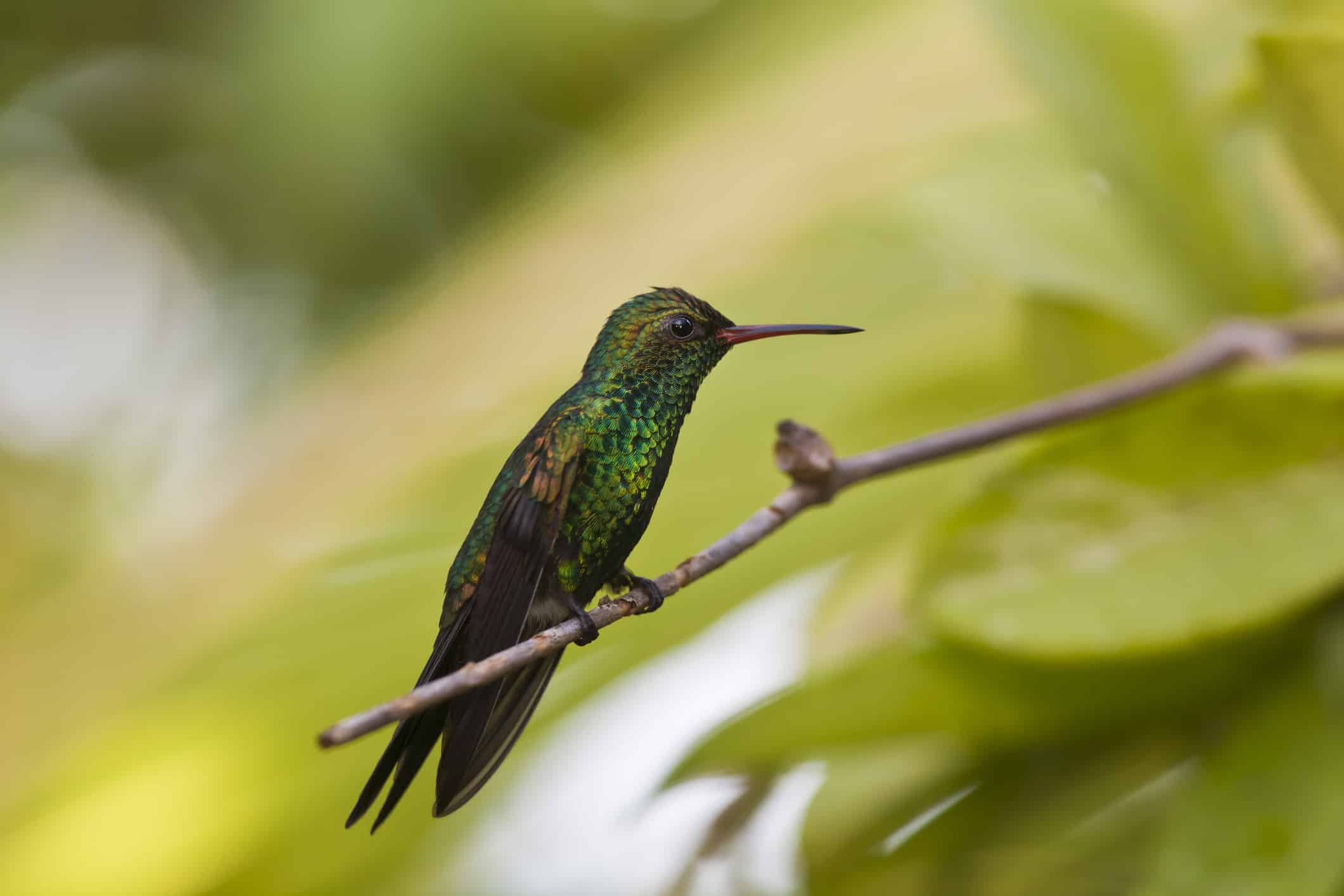Hummingbirds bring a touch of magic with their vibrant colors and mesmerizing flight to the landscape in Georgia. The ruby-throated hummingbird is the predominant species in the state. However, occasional sightings of other hummingbird species have also been reported as they pass through the state. Gardens, parks, woodlands, and areas with nectar-rich flowering plants are ideal spots to catch a glimpse of these beautiful birds. In this article, you will learn about the 12 types of hummingbirds in Georgia and the plants that attract them. So, without further ado, let’s get into it!
Types of Hummingbirds in Georgia
1. Ruby-Throated Hummingbird (Archilochus colubris)
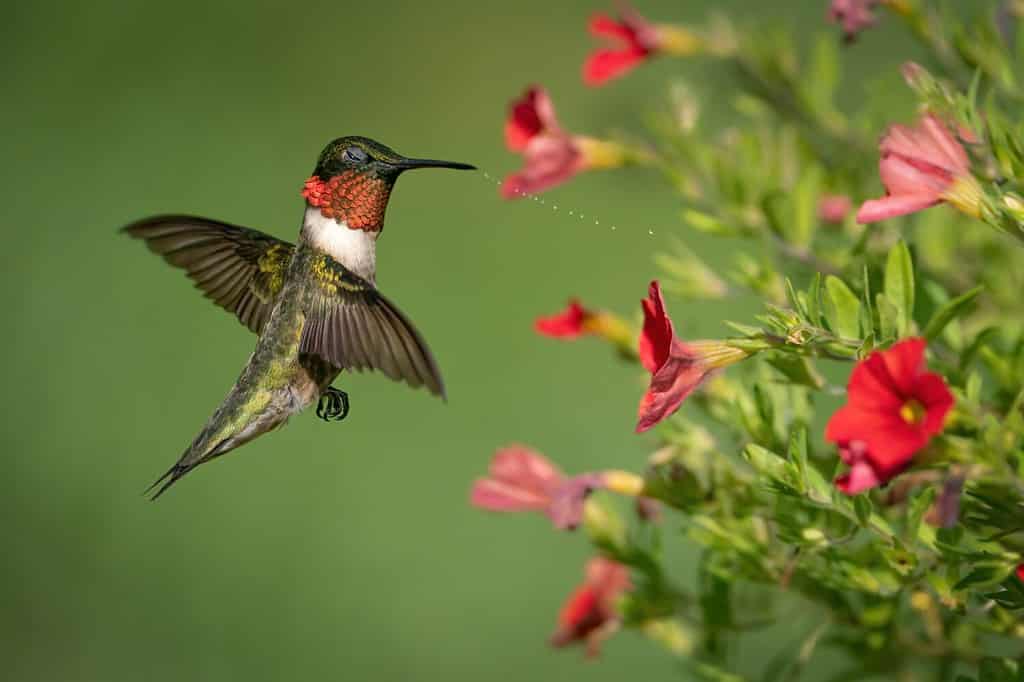
Weighing only around 0.1 ounces, ruby-throated hummingbirds are the most common hummingbird you’ll see in Georgia.
©Cavan-Images/Shutterstock.com
The ruby-throated hummingbirds, named after the male hummingbird’s gorgeous color, are one of the smallest bird species in the world. They weigh only about 0.11 ounces and are around 2.5 to 3.5 inches long. Notably, the male ruby-throated hummingbirds are about 20% smaller than females and have shorter bills. Male hummingbirds also have a ruby-red throat, metallic-green back and crown, and gray breasts. Females have green backs and are white underneath with brownish crowns and sides. Another difference between the two sexes is that the males have pointed tail feathers and a forked tail, while the females have rounded tail feathers and a fan-shaped tail. Juvenile ruby-throated hummingbirds look similar to adult female hummingbirds, even when they are male.
In terms of diet, ruby-throated hummingbirds sustain themselves on nectar from flowers and flowering trees, as well as small insects and spiders. You can find these beautiful hummingbirds in gardens, parks, woodlands, and near flowering plants, where they seek out nectar-rich sources for food. Coastal areas, as well as locations near water sources like rivers and lakes, can also be prime spots for observing these birds.
2. Rufous Hummingbird (Selasphorus rufus)

The rufous hummingbird has a rusty color and a long, straight bill.
©Keneva Photography/Shutterstock.com
When fully grown, the rufous hummingbird reaches around 2 to 3 inches long and weighs a mere 2 to 5 grams or 0.07 to 0.18 ounces. These hummingbirds are just one of nine species in the genus Selasphorus. In terms of appearance, they have a long, straight, and slender bill with a long extendable tongue. Interestingly, their name is influenced by the rufous, or rust-like, color of their feathers. The rufous color is prominent on their face, flanks, and tail. Furthermore, male and female rufous hummingbirds look a little different. Specifically, the adult male has a white breast and orange-red throat patch, while the adult female has a more muted shade on the throat patch.
Rufous hummingbird sightings are relatively rare in Georgia as they primarily breed in the western parts of North America, including the Pacific Northwest and southern Alaska. However, they may be sighted in Georgia during the fall and winter as they migrate to their wintering grounds in Mexico.
3. Black-Chinned Hummingbird (Archilochus alexandri)

The adult male black-chinned hummingbird has an iridescent purple throat while the female has a gray throat.
©rck_953/Shutterstock.com
The black-chinned hummingbird is a migratory bird; these hummingbirds breed in the western United States during the summer months. In winter, however, they migrate to the west coast of Mexico. Though they are rarely spotted in Georgia, you may be lucky to spot one as they migrate through the country. Since Georgia is generally not on their flight path, a black-chinned hummingbird you spot in this state is likely to have been blown off course!
A typical adult black-chinned hummingbird reaches approximately 3.25 inches in size and weighs about 0.1 to 0.2 ounces. The adult male has a black face and chin, an iridescent purple throat, and a dark forked tail. On the other hand, the female has a dark rounded tail with white tips and a gray throat patch. In terms of looks, the females look relatively similar to female ruby-throated hummingbirds. Female black-chinned hummingbirds are also known to exhibit territorial behavior when it comes to food and are more defensive during the breeding season. Their diet mainly consists of nectar, small insects, and spiders.
4. Calliope Hummingbird (Selasphorus calliope)

Male calliope hummingbirds also have iridescent purple streaks on their throats or gorgets
©iStock.com/McBenjamen
The smallest breeding bird in both Canada and the United States, the calliope hummingbird measures around 3 inches in length and weighs a mere 2 to 3 grams or 0.07 to 0.1 ounces. These hummingbirds are believed to be the smallest-bodied long-distance migrant in the world, as they can fly more than 5,000 miles each year from Mexico to Canada and back! They are a western North American species whose breeding range extends from the Pacific Northwest to the northern Rocky Mountains.
Calliope hummingbirds have glossy green backs and crowns that beautifully contrast their white underbellies. The males have wine-red streaks on their gorget (throat), green flanks, and dark tails. On the other hand, females and juveniles lack those iridescent throats and instead have a pinkish-white underside and dark tails highlighted with white tips. These birds find food by extracting nectar from flowers, sipping sap from holes drilled by sapsuckers, and hunting for insects.
5. Allen’s Hummingbird (Selasphorus sasin)
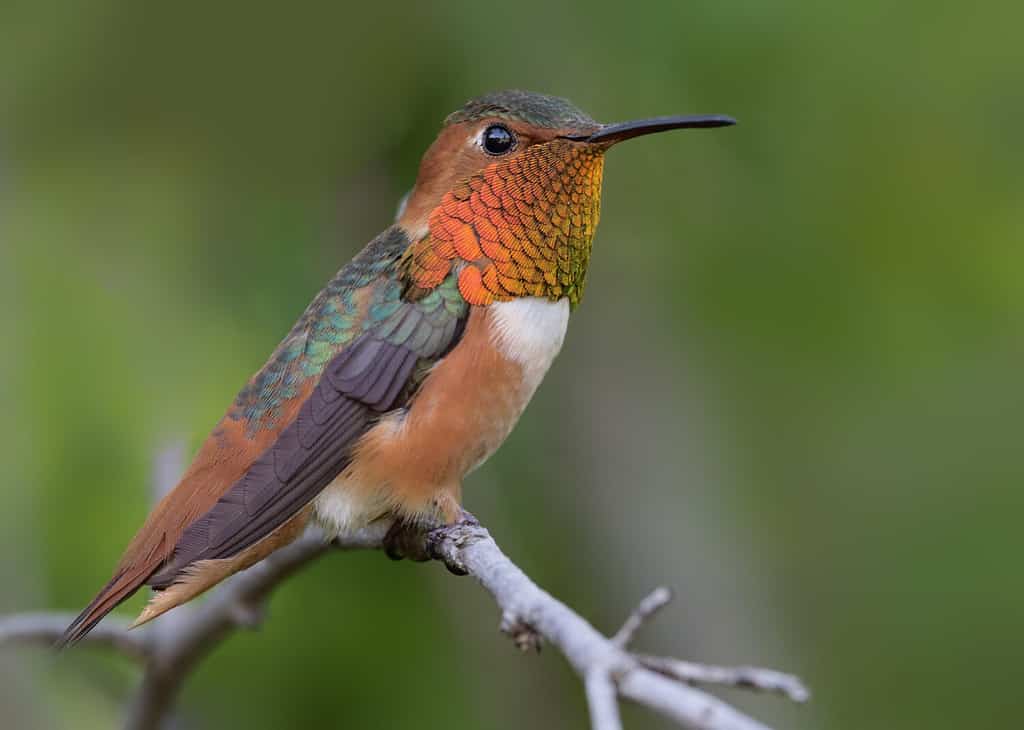
Although uncommon, if you’re lucky, you may spot an Allen’s hummingbird in Georgia.
©Angel DiBilio/Shutterstock.com
Allen’s hummingbirds have color markings similar to rufous hummingbirds, as both have green backs and prominent copper-orange coloration on their throat. The one significant difference in appearance between these two species is that the Allen’s hummingbird has narrow outer tail feathers, while the rufous hummingbird has a notched-tip appearance on its tail feathers. Another distinguishing feature is that the male Allen’s hummingbird tends to have a bronze-green back, while rufous hummingbirds have a more copper coloration. An adult Allen’s hummingbird typically grows to 3 to 3.5 inches long, weighs 0.1 ounces, and has a wingspan of 4.3 inches.
These gorgeous hummingbirds winter in Mexico and migrate as early as January to the Pacific Coast in California and Oregon, while some remain residents year-round in central Mexico and around Los Angeles. As you might be able to tell from their migratory path, these hummingbirds are not generally found in Georgia, but a couple have been spotted in the state over the years.
6. Buff-Bellied Hummingbird (Amazilia yucatanensis)
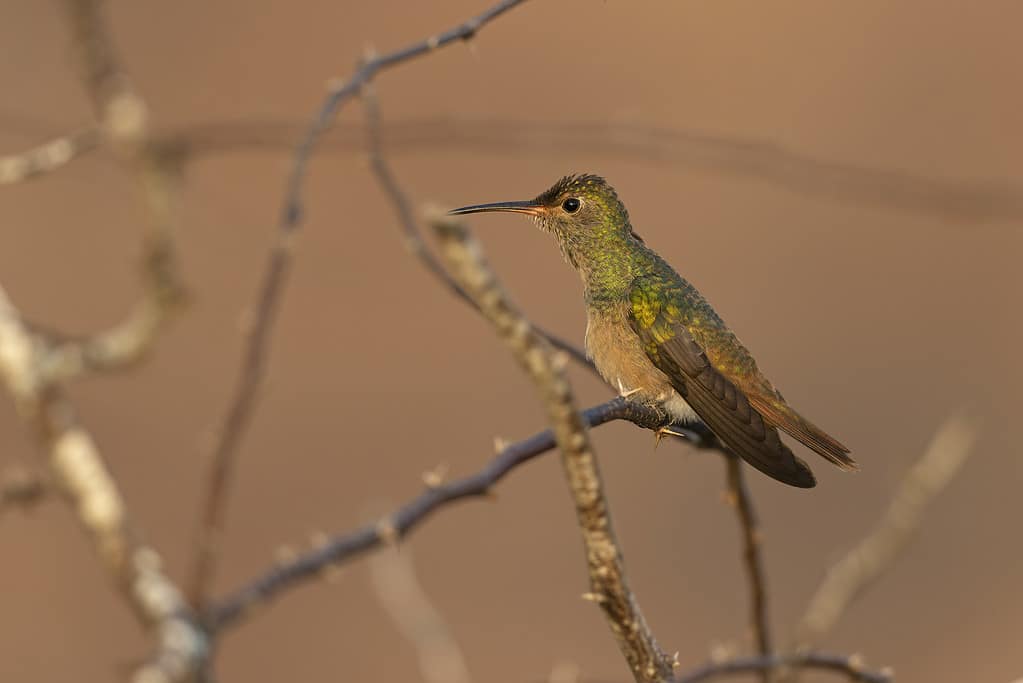
One of the largest hummingbirds is the buff-bellied hummingbird, which can grow up to 4.3 inches.
©BoukeAtema/iStock via Getty Images
Buff-bellied hummingbirds are larger than many other hummingbirds, earning their name, and they often use their size to intimidate other species and drive off competition. They have a buff belly and a long, red bill with a dark tip. These hummingbirds grow to about 3.9 to 4.3 inches in length and weigh about 0.1 to 0.2 ounces. Both sexes of the buff-bellied hummingbird species have a bronze-green color on their heads and backs, with blue-green breasts and throats and a rufous tail.
They are primarily found along the Gulf Coast of the United States but may occasionally and accidentally venture over to Georgia.
7. Anna’s Hummingbird (Calypte anna)
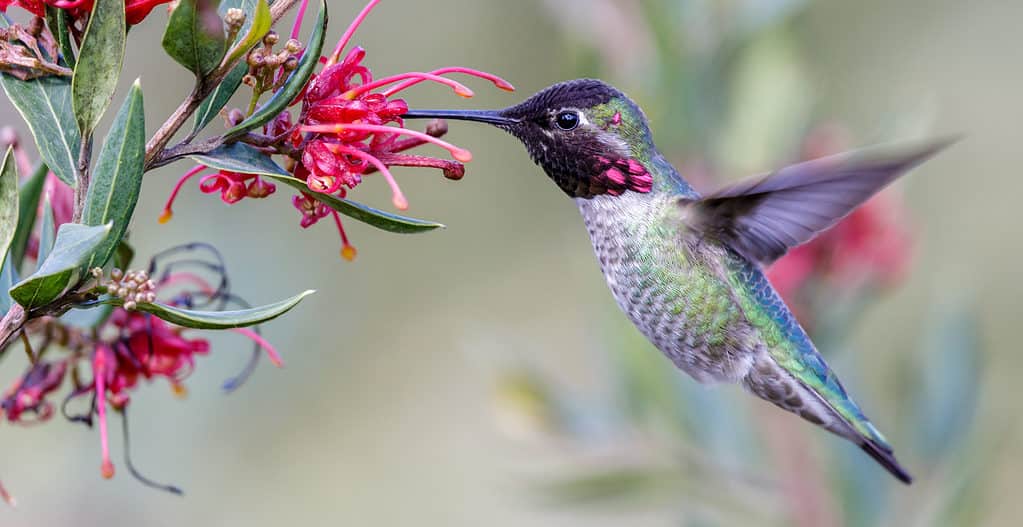
A vibrantly-colored bird, the Anna’s hummingbird is a permanent resident of the United States and Canada.
©yhelfman/Shutterstock.com
Anna’s hummingbird is a small bird with vibrant green feathers on its backside and an iridescent pinkish-red throat. The male Anna’s hummingbird has vibrant iridescent feathers with a bright magenta-red color on its throat, while the female hummingbird has a duller coloration, with green feathers and a pale throat. These hummingbirds measure around 3 to 4.3 inches in length and weigh about 0.1 to 0.21 ounces. Furthermore, their diet consists mainly of nectar from flowers, complemented with insects for protein.
Anna’s hummingbirds are one of three species that are permanent residents of the United States and Canada. While these hummingbirds are generally found along the Pacific Coast, they have occasionally and rarely been spotted in Georgia.
8. Broad-Billed Hummingbird (Cynanthus latirostris)
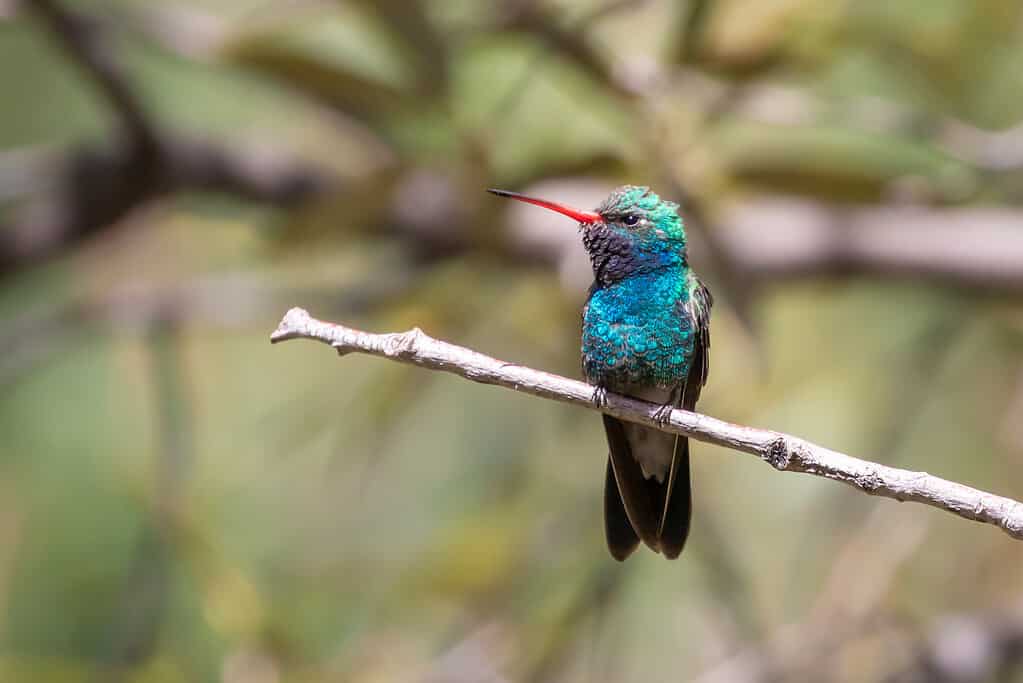
Primarily found in Mexico, the broad-billed hummingbird has rarely been spotted in Georgia.
©Jeff Huth/ via Getty Images
The broad-billed hummingbird is a brightly-colored hummingbird that is primarily found in Mexico and occasionally found in the southwestern United States. They grow to about 3.1 to 3.9 inches long and weigh only 3 to 4 grams or 0.1 ounces. The adult male broad-billed hummingbird is gorgeously striking in color – even in hummingbird terms. The males have an iridescent green back and a shimmering blue throat with a red bill. Females, on the other hand, are much more muted in color. Adult broad-billed hummingbird females are golden-green in color, with a gray underside, and a white line behind the eye.
While these hummingbirds are year-round residents of Mexico, they migrate north to southern Arizona and New Mexico for breeding in the summer months. These hummingbirds have occasionally and rarely been spotted in Georgia.
9. Green-Breasted Mango (Anthracothorax prevostii)
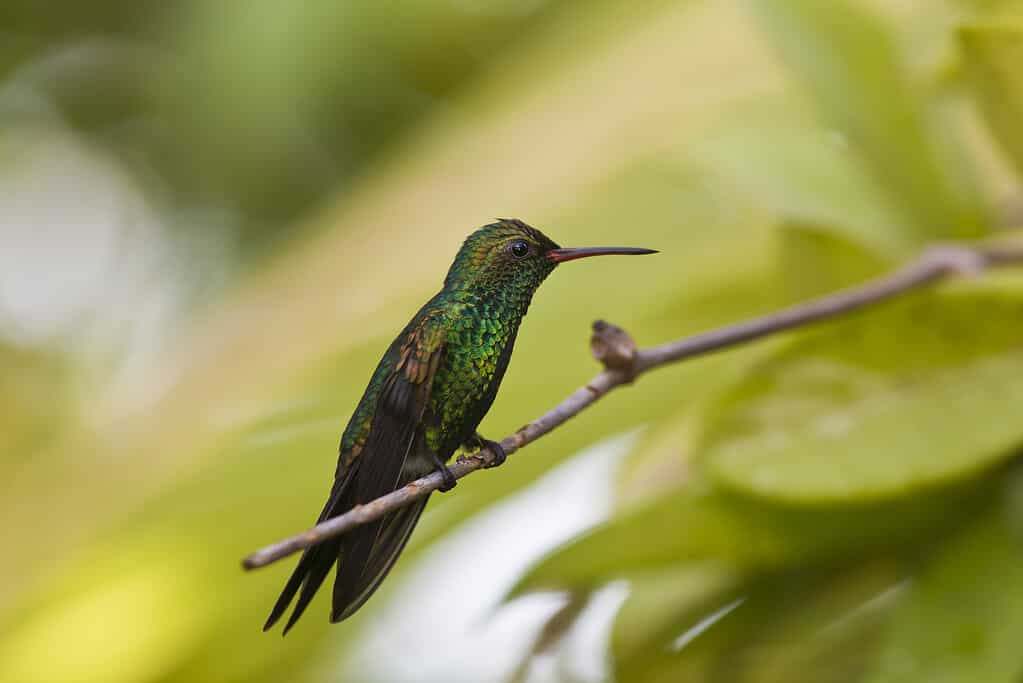
The green-breasted mango hummingbird is glossy and dark green in color.
©John Anderson/iStock via Getty Images
Another rare hummingbird species that you may be able to spot in Georgia is the green-breasted mango. The green-breasted mango hummingbird is known for its glossy, dark green coloration. Males of this species have a black throat with some blue on the chest, while females have white underbellies with a single black stripe and some blue-green metallic feathers. Adults of this medium-sized hummingbird are 4.3 to 4.7 inches in length and weigh around 0.24 to 0.25 ounces. Like other hummingbirds, green-breasted mangoes forage for nectar and insects.
Not many green-breasted mangoes have been spotted in the United States, as they are generally found near the coasts of Mexico and Central America, but they have occasionally been spotted in Texas and just once in Georgia.
10. Rivoli’s Hummingbird (Eugenes fulgens)
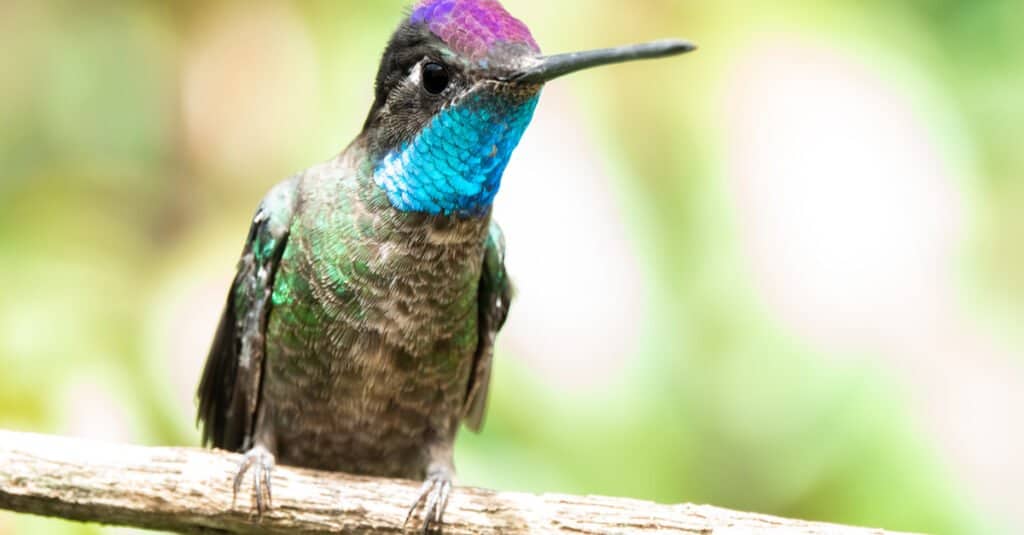
The second-largest hummingbird in the United States is the Rivoli’s hummingbird, which can reach up to 5.5 inches long.
©Jeroen Mikkers/Shutterstock.com
Also known as the magnificent hummingbird, Rivoli’s hummingbird is the second-largest hummingbird species in the United States. It reaches an adult size of 4.3 to 5.5 inches and weighs about 0.3 ounces. Adult males of this species are known for their striking colors: they have a shimmery green backside, which can appear as emerald or turquoise under sunlight, and a violet-blue patch on their head and throat. In contrast to the vibrant males, the females have pale gray throats and a green-black coloration on their backs. This dull coloration helps them camouflage when nesting.
If you ever spot a Rivoli’s hummingbird in Georgia, it is likely there by accident. While some individuals of this species have been spotted in this state in the past, it is a rare occurrence. Rivoli’s hummingbirds are residents of Mexico and Central America, with some migrating to southern Arizona, Texas, and New Mexico.
11. Broad-Tailed Hummingbird (Selasphorus platycercus)
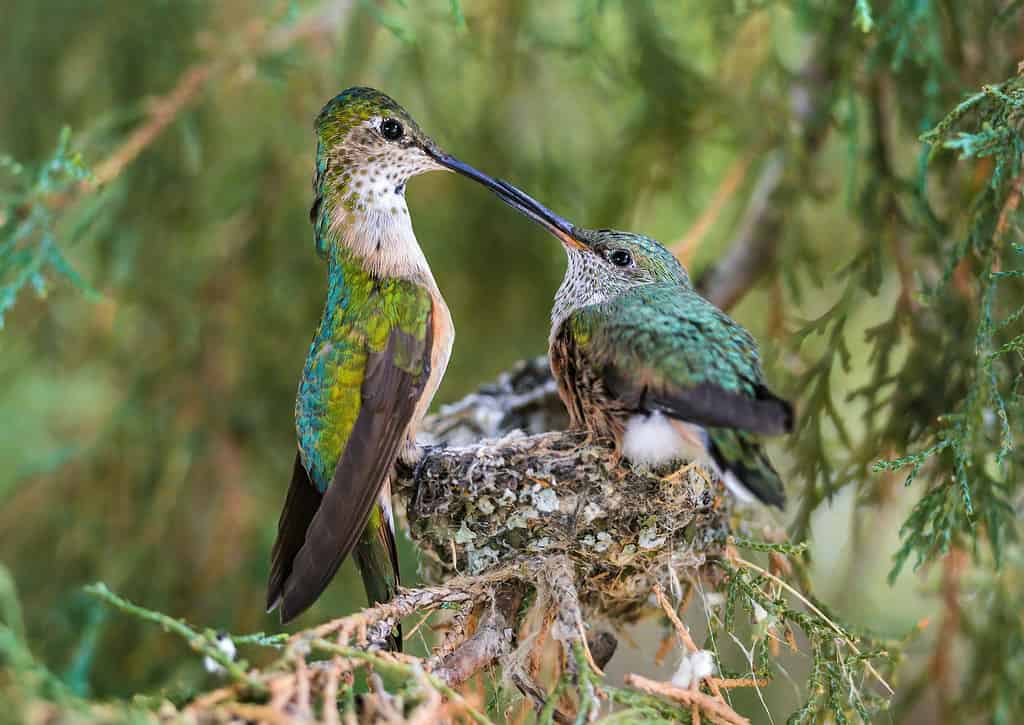
Females and immature broad-tailed hummingbirds have paler coloration and spotted cheeks.
©Susan Hodgson/Shutterstock.com
The broad-tailed hummingbird is named after its long, rounded black tail that projects beyond its wingtips when perched. Adults of both sexes have a shiny green back and a white eye ring. However, as usual, the male stands out with its bright rose-red gorget, while the female has a paler coloration and spotted cheeks. These hummingbirds grow to about 3 to 4 inches in length and weigh around 0.1 to 0.2 ounces.
While incredibly rare to spot in Georgia, broad-tailed hummingbirds have been spotted in the state in the past. However, generally, to see one, you’d have to travel west to California, Montana, Wyoming, or Idaho.
12. Blue-Throated Mountaingem (Lampornis clemenciae)

The largest hummingbird in the US, the blue-throated mountaingem measures up to 5 inches long.
©hstiver/iStock via Getty Images
The blue-throated mountaingem is the largest hummingbird that nests in the United States. It measures 4.3 to 5 inches in length and weighs about three times heavier than the ruby-throated hummingbird. These hefty hummingbirds can weigh up to 0.3 ounces. Male blue-throated mountaingems have a brilliant sapphire-colored gorget that shimmers in the sun, and both sexes are a bronze-green color on their backs with a gray belly.
Keep in mind that this hummingbird species is incredibly rare in Georgia and was only reported to be seen once. Instead, these hummingbirds are generally found in Arizona and Texas.
When Are Hummingbirds Most Active in Georgia?
The ruby-throated hummingbird is the primary nesting species in Georiga and the most frequently spotted hummingbird in the state. The state experiences two hummingbird seasons: the traditional season and the winter hummingbird season.
During the traditional season (March to October), there is the highest abundance of hummingbirds compared to any other time of the year. Most of these birds leave Georgia by October, with only a few remaining through the winter.
In the second season (November to mid-March), the rufous hummingbird becomes more prevalent. While it usually breeds in the Pacific Northwest and southern Alaska, many of these hardy birds spend their winters in Georgia, despite primarily migrating to Mexico. Roughly fifty to one hundred rufous hummingbirds are estimated to winter in Georgia each year.
Plants That Attract Hummingbirds in Georgia
1. Trumpet Vine (Campsis radicans)
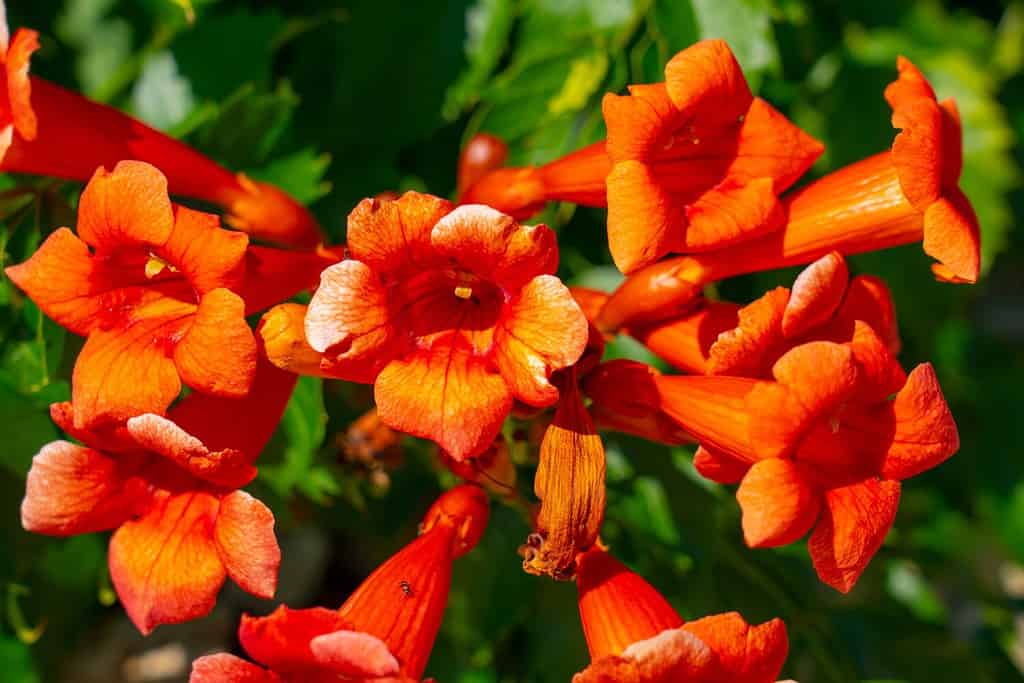
Hummingbirds love the bright colors of the trumpet vine, so this plant is perfect if you want to attract these tiny birds to your yard.
©martin.dlugo/Shutterstock.com
The trumpet vine, also known as trumpet creeper, is a hardy plant that is easy to grow and offers generous nectars from its flowers. Its tubular, fiery orange or red flowers resemble trumpets, perfectly suited for the hummingbird’s long beak. This plant is easy to grow in Georgia’s climate, as it thrives in full sun to partial shade and prefers well-draining soil. Trumpet vines can also be planted to climb trellises, fences, or walls to create a natural habitat for hummingbirds.
2. Rhododendron (Rhododendron)
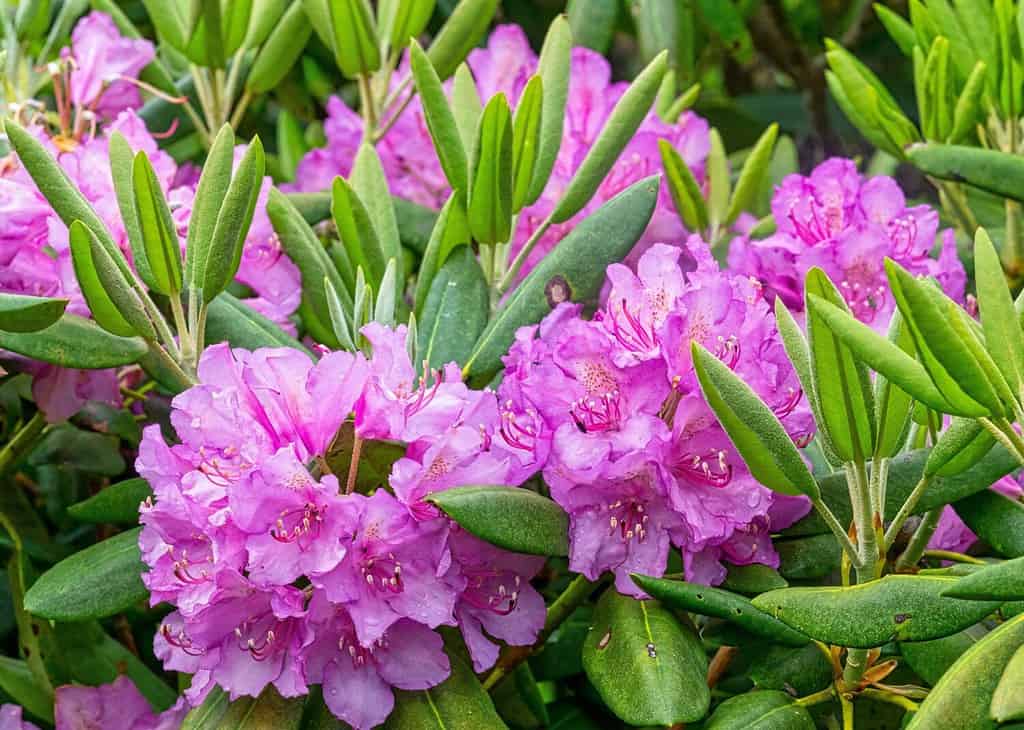
A flowering shrub, rhododendron attracts hummingbirds with its nectar-rich flowers.
©Donna Bollenbach/Shutterstock.com
The rhododendron is a beautiful flowering shrub that comes in various shades, such as pink, purple, and white. To grow rhododendrons successfully, choose a well-draining and acidic soil, and ensure they are placed in indirect sunlight or light shade. Not only do these beautiful shrubs create a lovely backdrop for hummingbirds to visit, but they also offer nectar-rich flowers that are beneficial to the birds.
3. Bee Balm Plant (Monarda)
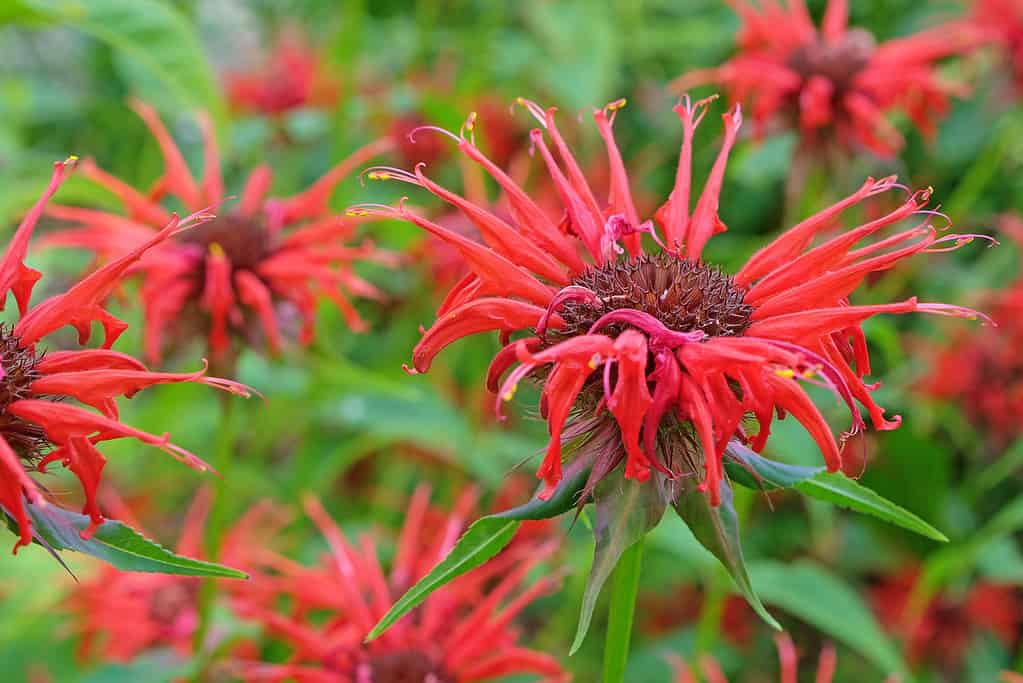
The vibrant flowers of the bee balm plant attract hummingbirds as well as other pollinators.
©Alex Manders/ via Getty Images
The bee balm plant is endemic to North America. It is a genus of flowering plants in the mint family and is best to plant in the early spring or fall. The bee balm plant has flowers in vibrant hues of red, pink, purple, or white, which attracts hummingbirds. It requires full sunlight and well-draining soil with good airflow. The flowers of this plant produce abundant nectar, an excellent fuel source for hummingbirds, ensuring they have the energy they require.
4. Red Cardinal Flower (Lobelia cardinalis)
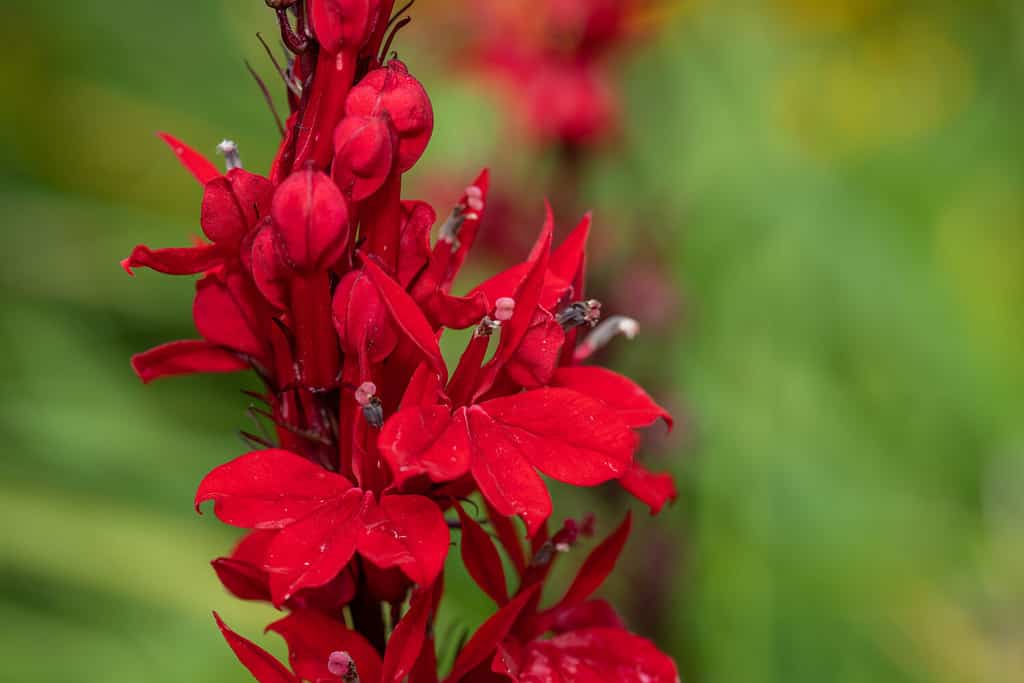
Want to attract hummingbirds? Grow a red cardinal flower to attract hummingbirds to your garden in Georgia.
©Tom Meaker/Shutterstock.com
The cardinal flower is a tall, upright plant with bright red tubular flowers that hummingbirds love. To plant cardinal flowers, choose a location with moist to wet soil and partial to full sunlight. These plants thrive near water features or in damp areas of your garden. This plant is beneficial to hummingbirds due to its high nectar content and unique flower shape, which perfectly accommodates the hummingbird’s long beak.
5. Hibiscus (Hibiscus syriacus)

Another favorite flower of hummingbirds in Georgia is the hibiscus, thanks to its bright colors and sweet nectar.
©Ward DeWitt/ via Getty Images
The hibiscus plant has large, showy flowers that come in a variety of colors, including shades of red, pink, orange, and yellow, making it a vibrant focal point. To plant a hibiscus, choose a sunny spot with well-draining soil. Regular watering and occasional fertilizing can promote healthy growth and abundant blooms. The hibiscus’s rich and sweet nectar serves as a delectable treat for hummingbirds.
6. Sage (Salvia)
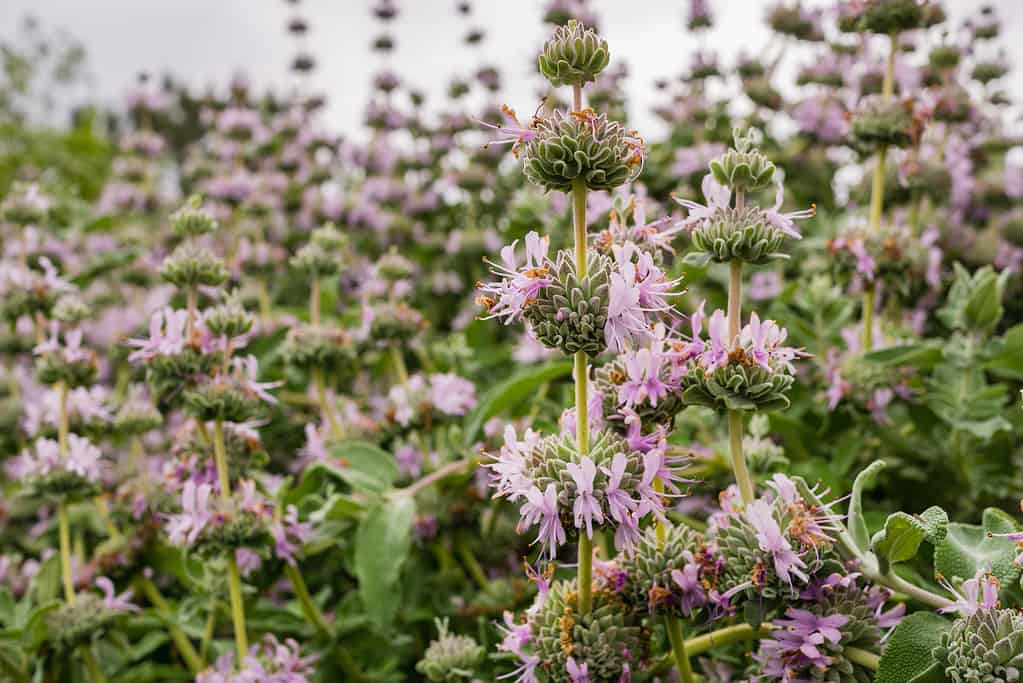
Sage has tubular flowers that attract hummingbirds. The plant’s leaves can also provide some shelter for these tiny birds.
©Sundry Photography/iStock via Getty Images
The sage plant has a cluster of woody stems with elongated textured leaves. It has vibrant tubular flowers of red, pink, and purple that catch the eyes of hummingbirds. They are rich in nectar, which provides high-energy fuel for hummingbirds to sustain their rapid metabolism and constant activity, especially during migration or breeding periods. The plant’s fragrant leaves also provide shelter and cover, creating a safe haven where hummingbirds can rest and perch. When planting a sage plant, select a sunny location with well-draining soil, and ensure proper watering without overdoing it to prevent root rot.
Summary of Hummingbirds In Georgia: 12 Types
| Number | Hummingbird | Scientific Name |
|---|---|---|
| 1 | Ruby-Throated Hummingbird | Archilochus colubris |
| 2 | Rufous Hummingbird | Selasphorus rufus |
| 3 | Black-Chinned Hummingbird | Archilochus alexandri |
| 4 | Calliope Hummingbird | Selasphorus calliope |
| 5 | Allen’s Hummingbird | Selasphorus sasin |
| 6 | Buff-Bellied Hummingbird | Amazilia yucatanensis |
| 7 | Anna’s Hummingbird | Calypte anna |
| 8 | Broad-Billed Hummingbird | Cynanthus latirostris |
| 9 | Green-Breasted Mango | Anthracothorax prevostii |
| 10 | Rivoli’s Hummingbird | Eugenes fulgens |
| 11 | Broad-Tailed Hummingbird | Selasphorus platycercus |
| 12 | Blue-Throated Mountaingem | Lampornis clemenciae |
Thank you for reading! Have some feedback for us? Contact the AZ Animals editorial team.

